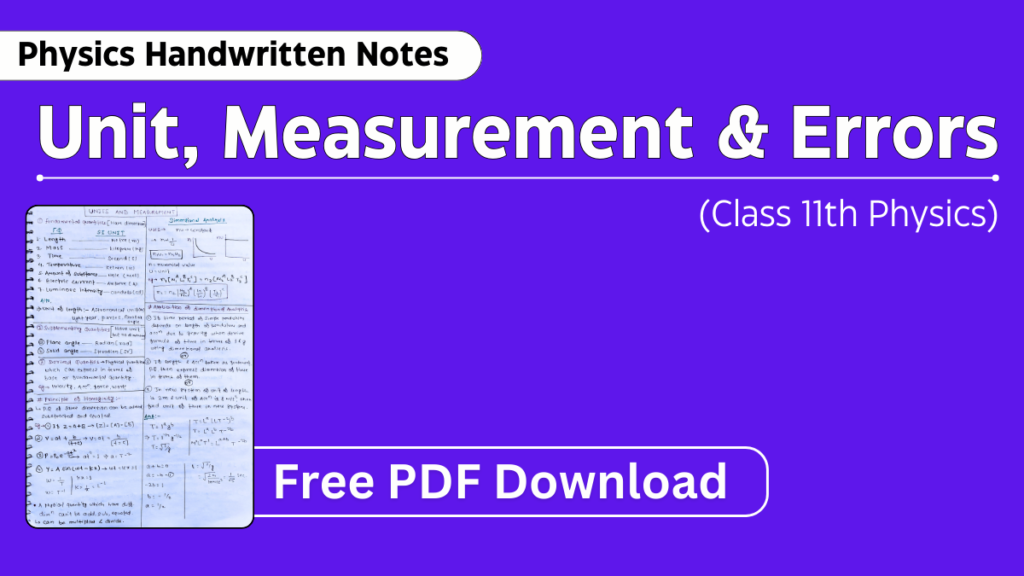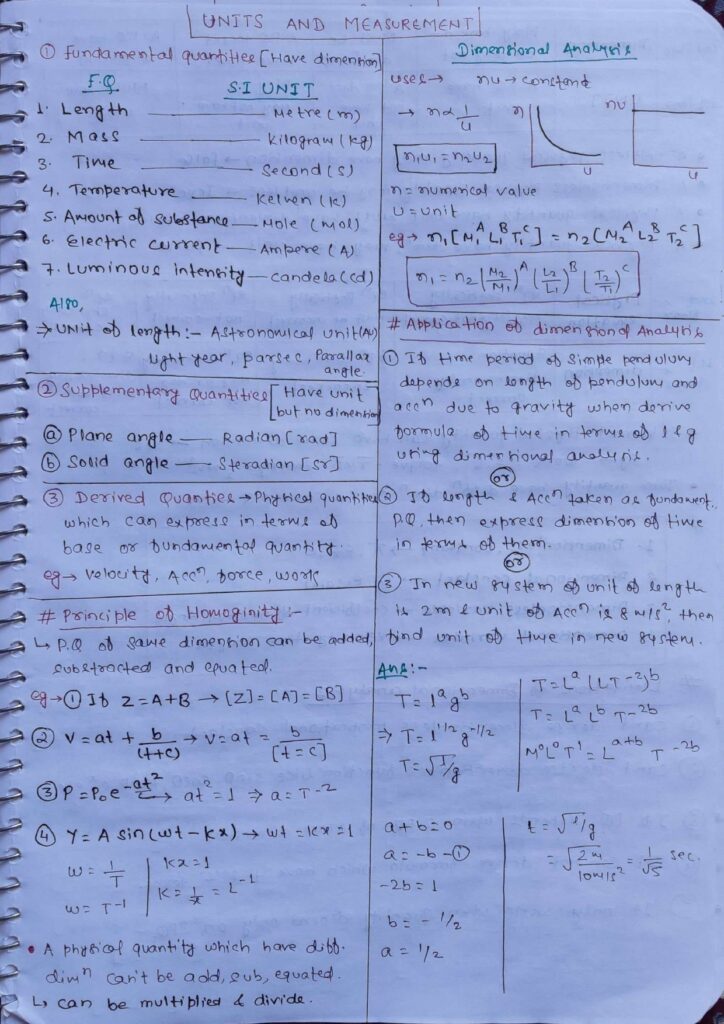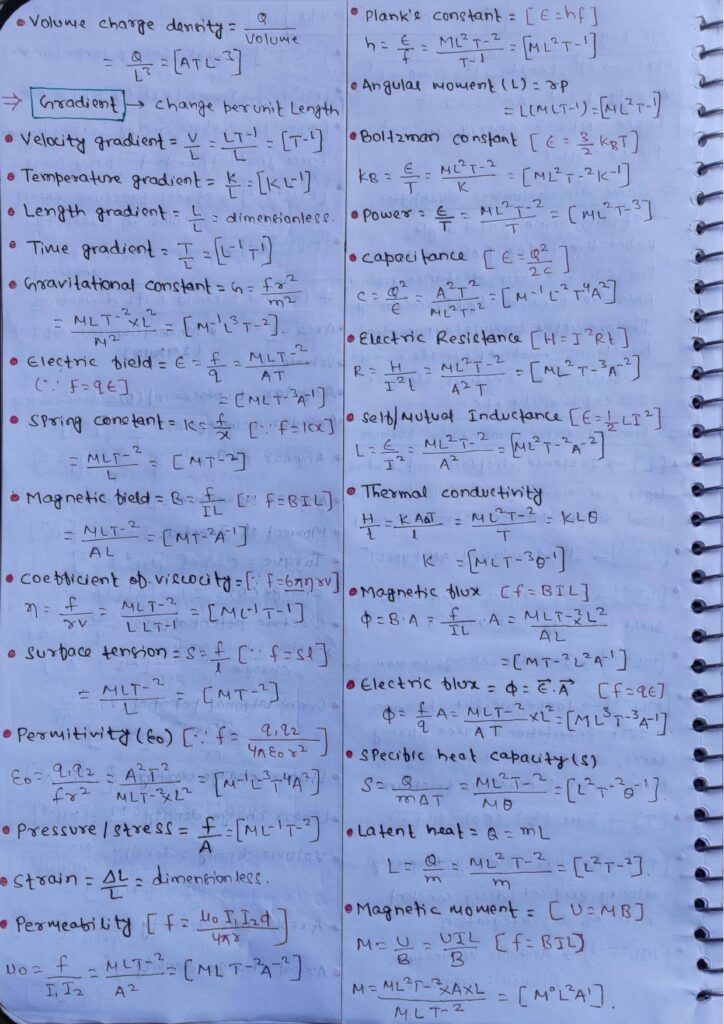Unit, Measurement and Errors is The Starting of Physics if you are preparing for Jee & Neet Exams also it’s First Unit of Class 11 Physics. In this article we are going to Share Unit, Measurement and Errors Best Handwritten Short Notes PDF. You can Use Unit Measurement and Errors Short Notes In your preparation. it will help you a lot.
These Notes are made my Top Kota faculties! so Contains each Important Topics, Go Bellow and Download PDF!

Unit Measurement and Errors Class 11 Physics Notes
Units and Measurements:
Units are the standardized quantities used to express measurements. They provide a reference against which measurements can be compared and understood universally. In the International System of Units (SI), seven base units form the foundation for all other units:
- Length: Meter (m)
- Mass: Kilogram (kg)
- Time: Second (s)
- Electric current: Ampere (A)
- Temperature: Kelvin (K)
- Amount of substance: Mole (mol)
- Luminous intensity: Candela (cd)
Derived units, such as velocity (m/s), density (kg/m³), and acceleration (m/s²), are derived from combinations of base units.
Errors in Measurements:
Errors are inevitable in measurements and can arise due to various factors:
- Systematic Errors: These errors occur consistently and are usually associated with the measuring instrument or experimental setup. Calibration errors or zero errors in instruments are examples of systematic errors.
- Random Errors: Random errors, also known as indeterminate errors, occur unpredictably and are caused by fluctuations in experimental conditions or human limitations in making measurements. They can be minimized by taking multiple measurements and calculating the average.
- Instrumental Errors: These errors stem from limitations in the measuring instruments themselves. They can include parallax errors, where the observer’s line of sight is not perpendicular to the scale being read.
- Human Errors: Mistakes made by the experimenter during the measurement process contribute to human errors. These can include misreading the scale, incorrectly recording data, or making incorrect adjustments to the instrument.
Error Analysis:
Understanding and quantifying errors is crucial in scientific endeavors. Error analysis involves determining the magnitude and sources of errors and their impact on the reliability of experimental results. Statistical methods such as standard deviation and propagation of errors are employed to analyze and minimize uncertainties in measurements.
Unit Measurement and Errors Handwritten Short Notes






1. What are the fundamental differences between units and dimensions?
Units are standardized quantities used to express measurements, while dimensions represent the physical properties being measured. Units provide the scale or magnitude of a measurement, whereas dimensions describe what is being measured, such as length, mass, time, etc. Understanding both units and dimensions is crucial for accurate and meaningful scientific measurements.
2. How are dimensional formulas useful in physics and engineering?
Dimensional formulas help in analyzing and predicting relationships between physical quantities. They provide insight into the nature of physical laws and equations by revealing the fundamental dimensions involved. Using dimensional analysis, scientists and engineers can check the consistency of equations, derive new relationships, and solve problems across different branches of physics and engineering.
3. Why is it important to use SI units in scientific measurements?
The International System of Units (SI) provides a globally standardized framework for expressing measurements, ensuring consistency and clarity in scientific communication. Using SI units simplifies calculations, facilitates collaboration among scientists worldwide, and avoids confusion arising from different units used in various regions or disciplines. For exams like JEE and NEET, proficiency in SI units is essential for accurate problem-solving and interpretation of questions.
4. How can one ensure the accuracy and precision of experimental measurements?
Accuracy and precision in experimental measurements are achieved through careful experimental design, proper calibration of instruments, and meticulous data collection and analysis. Taking multiple measurements, controlling experimental variables, and minimizing systematic errors are essential practices. Additionally, employing statistical techniques for error analysis, such as calculating uncertainties and using error bars, enhances the reliability of experimental results and conclusions.



